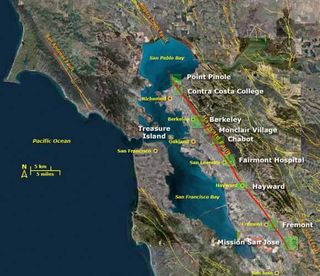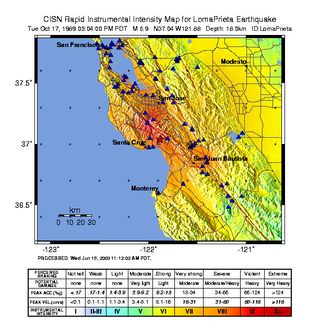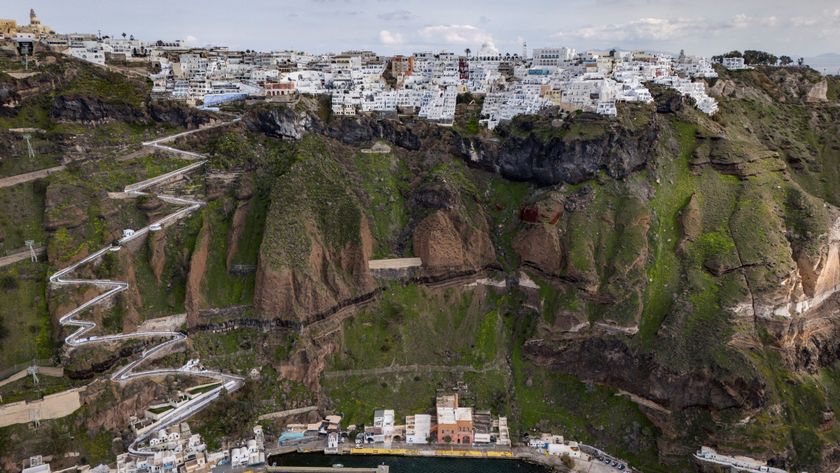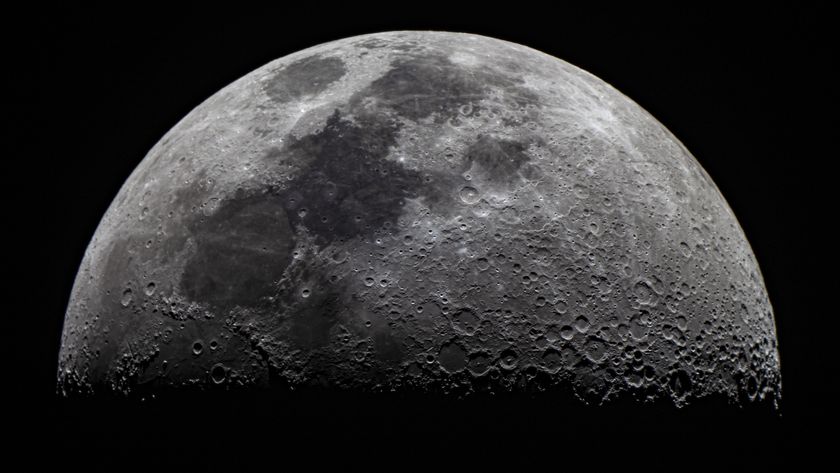25 Years After Loma Prieta, Earthquake Science Is Transformed

The Oct. 17, 1989, Loma Prieta earthquake was America's first widely-shared natural disaster. The calamity was captured live on television, as Game 3 of the World Series was about to start. The TV crews at San Francisco's Candlestick Park soon turned their cameras on the ravaged city, and frightening images poured in of people trapped in crumpled freeways, burning buildings and toppled storefronts.
The magnitude-6.9 Loma Prieta earthquake, centered below the Santa Cruz Mountains, shook much of central California. The resulting damage ultimately revitalized San Francisco, with a new waterfront replacing the demolished Embarcadero Freeway and a $30 billion investment from public and private organizations for redevelopment and seismic upgrades. San Francisco City Hall's Beaux Arts dome even got a fresh coat of gold leaf gilding.
In the last 25 years, earthquake science and engineering have kept pace with the Bay Area's tremendous transformation. After watching houses and bridges collapse on top of jellylike soils, the city enacted stricter building codes for new and existing structures. Satellites now supplement a denser network of sensors that track each hazardous fault and help forecast future earthquakes. And an early warning system for earthquake shaking — the first such system in the United States — is being tested. [Loma Prieta Earthquake: 25th Anniversary in Pictures]
"We've made amazing progress, but we should be doing a whole lot more," said Mary Lou Zoback, a consulting professor at Stanford University in Palo Alto, California.
The "Big One" is coming
The Loma Prieta earthquake most likely broke along a fault that slopes to the west beneath Loma Prieta peak. The San Andreas Fault slices through the same spot. To this day, geologists still disagree about where the earthquake occurred. Some researchers think the epicenter was on the San Andreas Fault; others favor the tilted fault, one of several "strands" that weave alongside this section of the San Andreas Fault. If the tilted fault is the culprit, then the Loma Prieta earthquake may not have released all of the seismic tension stored beneath the Santa Cruz Mountains.
"At first, we thought it was just a run-of-the-mill San Andreas earthquake, but of course that did not turn out to be the case. That was a big surprise," Zoback said.
Sign up for the Live Science daily newsletter now
Get the world’s most fascinating discoveries delivered straight to your inbox.
The Loma Prieta earthquake did ease tension elsewhere in the Bay Area, especially along the southern Hayward Fault, which is considered most likely to rupture next. The Hayward Fault typically slides a few millimeters (less than 0.2 inches) each year without generating earthquakes. After Loma Prieta, the Hayward Fault barely moved until 1995, when it suddenly crept 25 millimeters (0.98 inches). Geologists surmised that the earthquake had relaxed seismic strain on the Hayward Fault.

The next Bay Area earthquake could be on any fault. Seven major faults slice across the Bay Area: the San Andreas, Hayward-Rodgers Creek (two faults), Calaveras, Concord-Green Valley (two faults) and Greenville Faults.
Their early earthquake history is no longer as mysterious as it was 25 years ago. Geologists have dug deeply into the major faults to determine the dates of prehistoric earthquakes. A network of GPS devices and satellites also tracks the tension building up on these same faults, and detects how much these faults move during earthquakes. Together, these ancient and modern histories can be translated into a forecast of future earthquakes.
"We have a much better understanding of the long-term earthquake probabilities," said Brad Aagaard, a research geophysicist at the U.S. Geological Survey's (USGS) Earthquake Science Center in Menlo Park, California.
The USGS says the probability of a magnitude-6.7 earthquake on the Hayward Fault in the next 30 years is 30 percent. There's a 63 percent chance of a major earthquake (magnitude 6.7) somewhere in the Bay Area in the next 30 years.
Technology leaps forward
The World Wide Web was only an eight-month-old proposal when the Loma Prieta earthquake struck. Today, the Internet instantly alerts the world to the chaos and destruction caused by major earthquakes.
The USGS automatically generates maps of shaking intensity within seconds of most major earthquakes, identifying the hardest-hit areas. The system also estimates total fatalities and economic losses. (Most loss of life and damage during an earthquake stems from ground shaking.) [Video: Loma Prieta Earthquake Shakes the Bay Area]
Compare the instant information to the scramble after Loma Prieta, when geologists worked in the dark to try to determine the quake's size and impact. "One of the most striking things, in looking back, is that there really wasn't enough network instrumentation to say, 'Here was the distribution of shaking, and here was the impact,'" Aagaard said.
Scientists have vastly improved the network of instruments that measure California earthquakes. At the time of Loma Prieta, the Bay Area had 75 ground motion sensors. Now, there are 580 stations in northern and central California, and researchers hope to install even more.
For example, the Berkeley Seismological Laboratory is developing an early-alert system to warn of earthquake shaking. The network needs scores of new seismometers to fill in existing gaps and upgrade outdated equipment that can't transmit quick alerts.
California lawmakers enacted the prototype warning system, called ShakeAlert, in 2013, but the legislation did not earmark the necessary $80 million startup funding for the joint effort between the University of California, Berkeley; Caltech; and the University of Washington.
After the earthquake, Caltrans crews demolishing the collapsed Cypress Street Viaduct in West Oakland had 20 seconds of warning before aftershocks hit. The crude system relied on seismometers to pick up trembling in the Santa Cruz Mountains, then relayed the warning via a radio network.
The ShakeAlert system relies on the same principles — distant earthquake sensors transmit warnings before shaking arrives. During the recent Napa earthquake, ShakeAlert testers received 5 to 10 seconds of warning time before the seismic waves rattled Berkeley and San Francisco.
Prepare and survive
The Loma Prieta earthquake was a horrific reminder of the hazards of building on soft, wet muds and clay. The same type of soils had liquefied during San Francisco's deadly 1906 earthquake, Zoback said. Loose sand and silt saturated with water can behave like a liquid when shaken by an earthquake. [Photos: The Great San Francisco Earthquake]
"Soft soils really amplify the shaking, and that certainly was the case for the Cypress freeway structure that collapsed, and the Marina District," Zoback said.
Some regions not only jiggled like jelly; they trembled like bowls of the stuff. In the Santa Clara Valley, a depression filled with layers of sediment, the seismic waves reflected off the Earth's crust and zigzagged around the valley like waves in a bathtub, increasing the severity of the shaking.
"The Loma Prieta earthquake brought to light how basins can affect shaking," Aagaard said.

Engineering geologists watched closely as 745 aftershocks rumbled through the devastated areas, to better understand how shaking affected different materials. "We had seismometers recording ground motion from the aftershocks in the Marina and just up the hill in Pacific Heights, on hard rock," Zoback recalled. "The Marina shook 10 times harder even though it was just a few blocks away."
These assessments were used to upgrade local building codes, and now, many Bay Area structures are more resilient to quakes. However, most building codes apply only to new construction, so last year, San Francisco passed a law requiring multiunit buildings built before 1978 to undergo a seismic retrofit.
Resilience and renewal
Loma Prieta isn't the worst-case scenario for San Francisco. That's because the earthquake was less powerful than the 1906 temblor, and was centered far from urban areas. The entire Bay Area is an earthquake hazard zone, with several faults beneath city lifelines. And the Aug. 24 Napa earthquake has reminded people that even an insignificant fault can have pretty significant earthquakes, Zoback said.
In the end, the Loma Prieta earthquake had little long-term effect on the regional economy, researchers have concluded. The total economic disruption hit $2.9 billion after two months, but 80 percent of these losses were recovered during the first six months of 1990, according to a USGS study.
Will the Bay Area bounce back so quickly after the next big earthquake?
Many public utilities have strengthened their systems since Loma Prieta hit, but the San Francisco airport, the BART rail system, the ports, the highways and the Golden Gate Bridge may not withstand severe shaking from a direct hit, experts say.
The Bay Area's demographics have also dramatically changed since the 1990s. Now, the population totals 7.7 million people, instead of 6 million, and has the country's second-widest gap between the rich and the poor, according to a study from the Brookings Institution.
"I think one of the things reinforced by Hurricane Katrina is, how do you deal with people who can't live in their homes afterwards?" Aagaard said. Resources will be stretched thin after a Bay Area earthquake, so it's important that those who can prepare do so now, so help can go where it's needed most, he said.
"In some respects, the Napa earthquake was a somewhat gentle reminder that we do have earthquakes and we do need to be prepared."
Email Becky Oskin or follow her @beckyoskin. Follow us @livescience, Facebook & Google+. Original article on Live Science.



